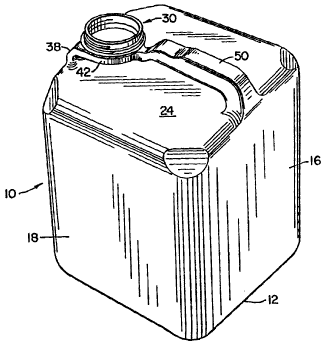Some of the information on this Web page has been provided by external sources. The Government of Canada is not responsible for the accuracy, reliability or currency of the information supplied by external sources. Users wishing to rely upon this information should consult directly with the source of the information. Content provided by external sources is not subject to official languages, privacy and accessibility requirements.
Any discrepancies in the text and image of the Claims and Abstract are due to differing posting times. Text of the Claims and Abstract are posted:
| (12) Patent: | (11) CA 2144444 |
|---|---|
| (54) English Title: | VENTED PLASTIC BOTTLE |
| (54) French Title: | BOUTEILLE DE PLASTIQUE AVEC PRISE D'AIR |
| Status: | Expired |
| (51) International Patent Classification (IPC): |
|
|---|---|
| (72) Inventors : |
|
| (73) Owners : |
|
| (71) Applicants : | |
| (74) Agent: | NORTON ROSE FULBRIGHT CANADA LLP/S.E.N.C.R.L., S.R.L. |
| (74) Associate agent: | |
| (45) Issued: | 1998-02-10 |
| (86) PCT Filing Date: | 1994-04-11 |
| (87) Open to Public Inspection: | 1995-01-26 |
| Examination requested: | 1995-11-30 |
| Availability of licence: | N/A |
| (25) Language of filing: | English |
| Patent Cooperation Treaty (PCT): | Yes |
|---|---|
| (86) PCT Filing Number: | PCT/US1994/003909 |
| (87) International Publication Number: | WO1995/002352 |
| (85) National Entry: | 1995-03-10 |
| (30) Application Priority Data: | ||||||
|---|---|---|---|---|---|---|
|
A container having a neck arrangement
including a circular spout (30) and a guiding neck
portion with a U-shaped ledge (60). During a pouring
operation the ledge directs liquid from the
container over the front edge of the spout (78) and
permits air to enter the container through the rear
portion of the spout (63) and an air passageway
(58) connecting the rear of the spout with the
inside of the container.
Contenant dont le goulot est constitué d'un dispositif muni d'un bec circulaire (30) et d'un support de guidage en forme de U (60). Lorsqu'on déverse un liquide, le rebord de ce support fait passer ce liquide par-dessus le bord antérieur du bec (78) tout en laissant entrer l'air dans le contenant par une section située à l'arrière du bec (63) et par un passage (58) pratiqué entre la section arrière du bec et l'intérieur du contenant.
Note: Claims are shown in the official language in which they were submitted.
Note: Descriptions are shown in the official language in which they were submitted.

For a clearer understanding of the status of the application/patent presented on this page, the site Disclaimer , as well as the definitions for Patent , Administrative Status , Maintenance Fee and Payment History should be consulted.
| Title | Date |
|---|---|
| Forecasted Issue Date | 1998-02-10 |
| (86) PCT Filing Date | 1994-04-11 |
| (87) PCT Publication Date | 1995-01-26 |
| (85) National Entry | 1995-03-10 |
| Examination Requested | 1995-11-30 |
| (45) Issued | 1998-02-10 |
| Expired | 2014-04-11 |
There is no abandonment history.
| Fee Type | Anniversary Year | Due Date | Amount Paid | Paid Date |
|---|---|---|---|---|
| Application Fee | $0.00 | 1995-03-10 | ||
| Registration of a document - section 124 | $0.00 | 1996-03-07 | ||
| Maintenance Fee - Application - New Act | 2 | 1996-04-11 | $100.00 | 1996-04-10 |
| Maintenance Fee - Application - New Act | 3 | 1997-04-11 | $100.00 | 1997-04-10 |
| Final Fee | $300.00 | 1997-10-29 | ||
| Maintenance Fee - Patent - New Act | 4 | 1998-04-14 | $100.00 | 1998-04-08 |
| Maintenance Fee - Patent - New Act | 5 | 1999-04-12 | $150.00 | 1999-04-06 |
| Maintenance Fee - Patent - New Act | 6 | 2000-04-11 | $150.00 | 2000-03-21 |
| Maintenance Fee - Patent - New Act | 7 | 2001-04-11 | $150.00 | 2001-03-20 |
| Maintenance Fee - Patent - New Act | 8 | 2002-04-11 | $150.00 | 2002-03-08 |
| Maintenance Fee - Patent - New Act | 9 | 2003-04-11 | $150.00 | 2003-03-05 |
| Maintenance Fee - Patent - New Act | 10 | 2004-04-12 | $250.00 | 2004-03-15 |
| Maintenance Fee - Patent - New Act | 11 | 2005-04-11 | $250.00 | 2005-03-21 |
| Maintenance Fee - Patent - New Act | 12 | 2006-04-11 | $250.00 | 2006-03-17 |
| Back Payment of Fees | $250.00 | 2006-03-29 | ||
| Maintenance Fee - Patent - New Act | 13 | 2007-04-11 | $250.00 | 2007-03-08 |
| Maintenance Fee - Patent - New Act | 14 | 2008-04-11 | $250.00 | 2008-03-07 |
| Maintenance Fee - Patent - New Act | 15 | 2009-04-13 | $450.00 | 2009-03-16 |
| Maintenance Fee - Patent - New Act | 16 | 2010-04-12 | $450.00 | 2010-03-19 |
| Maintenance Fee - Patent - New Act | 17 | 2011-04-11 | $450.00 | 2011-03-09 |
| Maintenance Fee - Patent - New Act | 18 | 2012-04-11 | $450.00 | 2012-03-14 |
| Maintenance Fee - Patent - New Act | 19 | 2013-04-11 | $450.00 | 2013-03-14 |
Note: Records showing the ownership history in alphabetical order.
| Current Owners on Record |
|---|
| RING CAN CORPORATION |
| Past Owners on Record |
|---|
| RING, CARL D. |